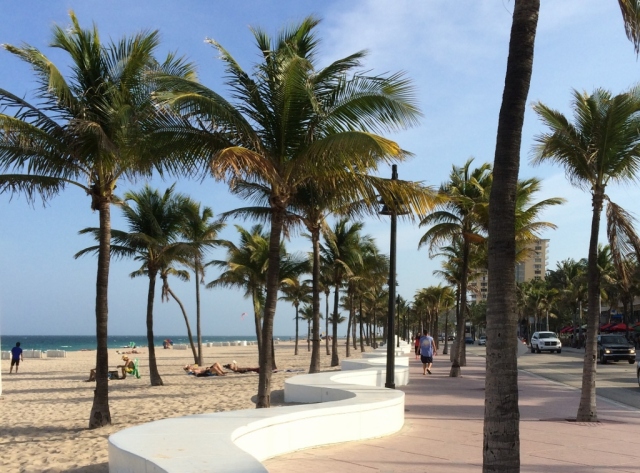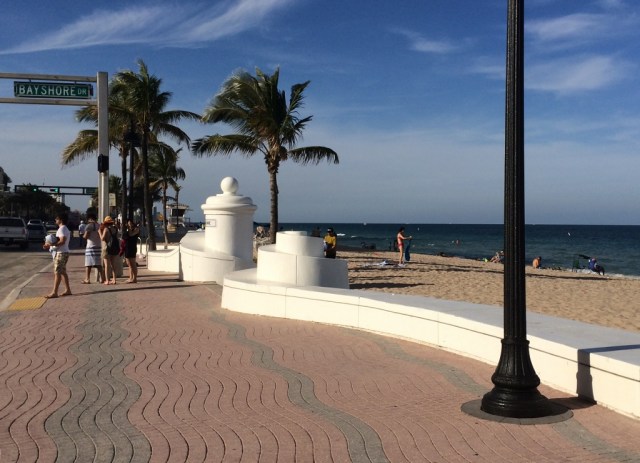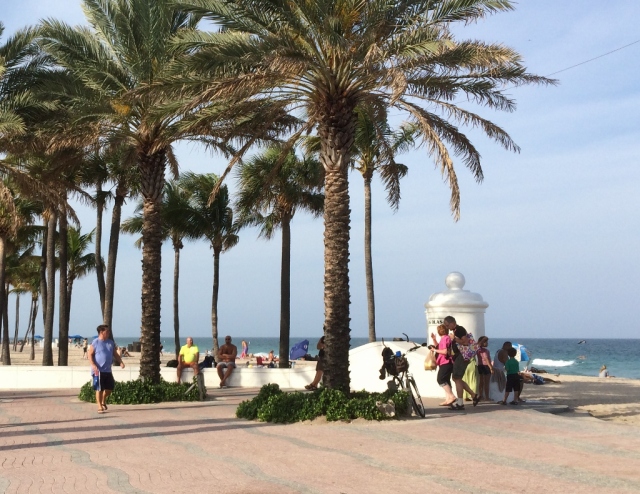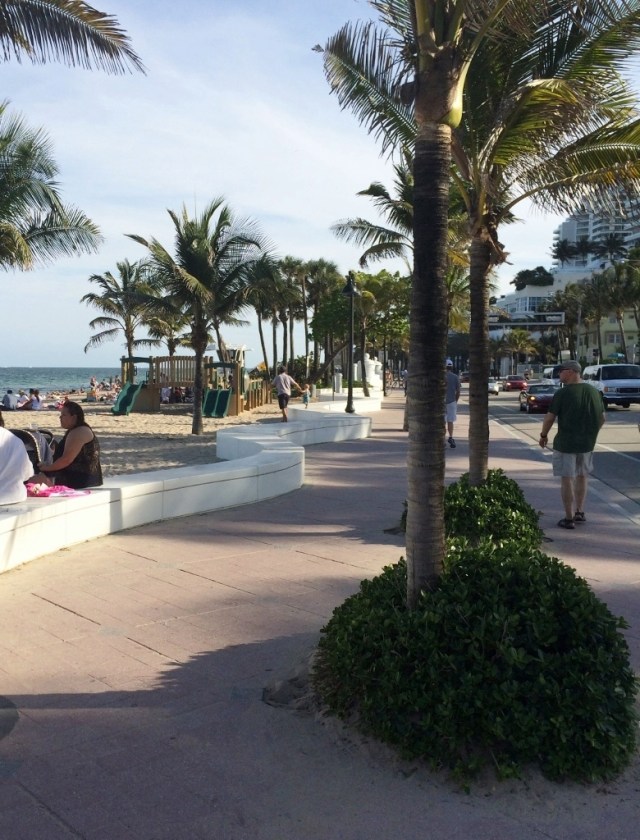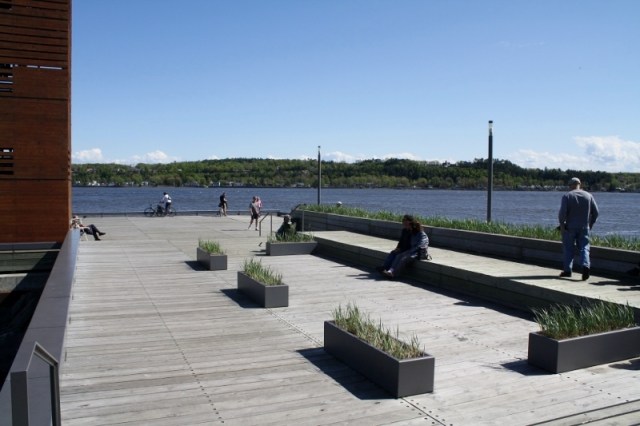While attending an outdoor concert at the North Carolina Museum of Art in the late 1990s, I remember feeling curious about a seemingly odd series of large shapes in various materials lined up between the museum building and the amphitheater. I also wondered about the geometric forms protruding from the stage in strange directions, and a gray-painted rectangle superimposed on part of theater seating area. I never closely investigated the objects, being more interested in the musical entertainment at that time. Then I happened to see an aerial image of the site, discovering that the shapes are actually letters spelling “Picture This”— clever, but really only when viewed from above. I later learned that some of the letters include phrases that reference the history, culture, and landscape of North Carolina – at least that is something to be gained when viewing the objects at ground level, where most people see them.
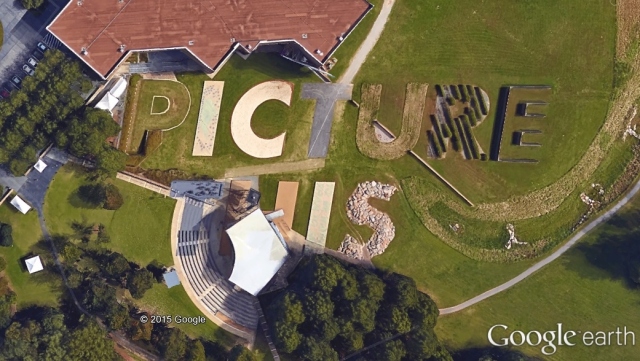
“Picture This”, a sculptural installation at the North Carolina Museum of Art
In my opinion, for art to successfully function as part of the landscape of a public space, it not only needs to be comprehensible from eye level; it also should communicate well with its surroundings. Furthermore, the design should include a sufficient amount of elements at human scale (such as seating and planted areas), especially when a plan includes vast expanses of pavement. In recent years, various blogs I’ve followed have included striking images of public landscapes with interesting flowing forms, geometric lines and shapes, and bright colors. Many of these photos, however, were taken from above. For some projects, aerial images were the only ones included, which makes me wonder whether these spaces truly work: Are they comfortable and inviting places? Do people tend to linger in these settings, or are they devoid of much activity?
One such project that intrigues me is the seafront promenade in Benidorm, Spain, probably because of its rainbow of pavement colors and curvy walls which mimic ocean waves. I haven’t visited this beach, so I couldn’t say whether it succeeds as a public space, but I like how each color lends some identity to every section of this extensive walkway, instead of repeating the same pattern and/or colors along its entire length. I think that certain unifying elements are important throughout any type of site design; but long, linear spaces should include some variety as well, to avoid creating a monotonous experience along these corridors.

Seafront promenade, Benidorm, Spain
For comparison, in another part of Spain, a median promenade along the Avenida de Portugal, in Madrid, includes large flower motifs throughout its length, referencing a valley in the region known for its cherry blossoms. The median is actually the roof of a highway tunnel, and the image below only shows one portion of this walkway. I’m curious to know whether this space is well-used.

Avenida de Portugal, Madrid, Spain
The following aerial images include a few more public spaces which are fascinating and attractive when viewed in two dimensions. Some of these and others that I’ve seen in photos from above make me think of abstract paintings or fiber art works. Do they function well in 3-D at human level? I will reserve judgment until and unless I have the chance to experience them in person. (Even photos taken from the ground don’t often give me a sense of how a space feels.) If any of my readers have been to these or other sites with an emphasis on artistic forms, I would love to hear some comments.

Grand Canal Square, Docklands, Dublin, Ireland
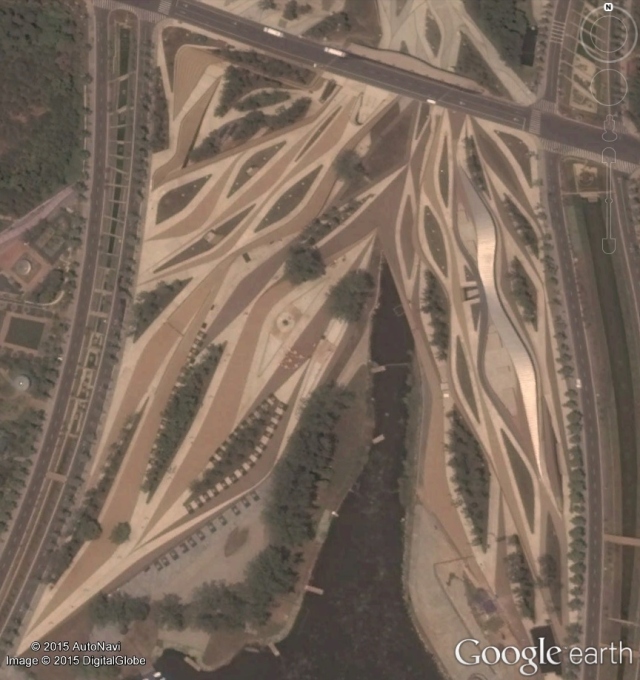
Earthly Pond Service Center, International Horticulture Exposition, Qingdao, China
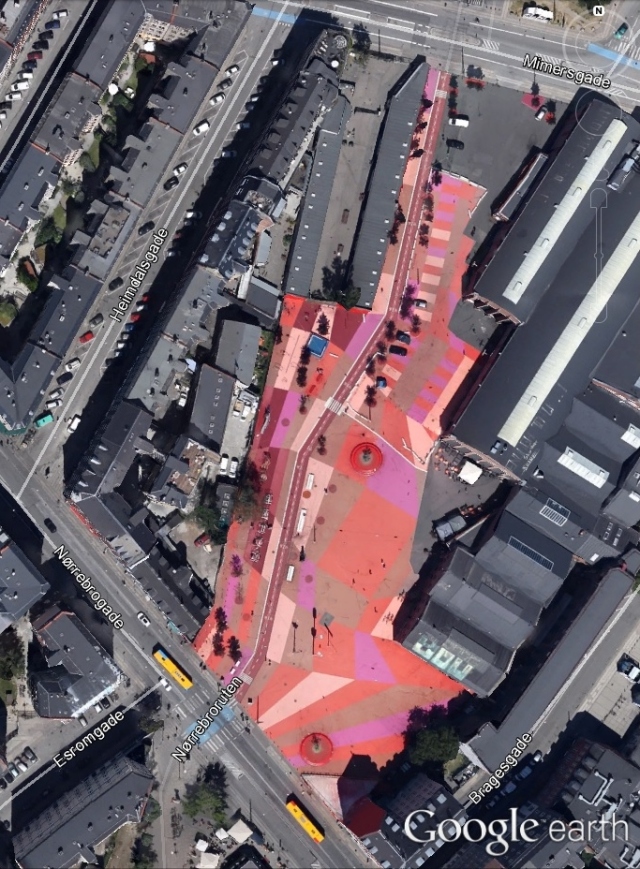
Superkilen (south section), Copenhagen, Denmark
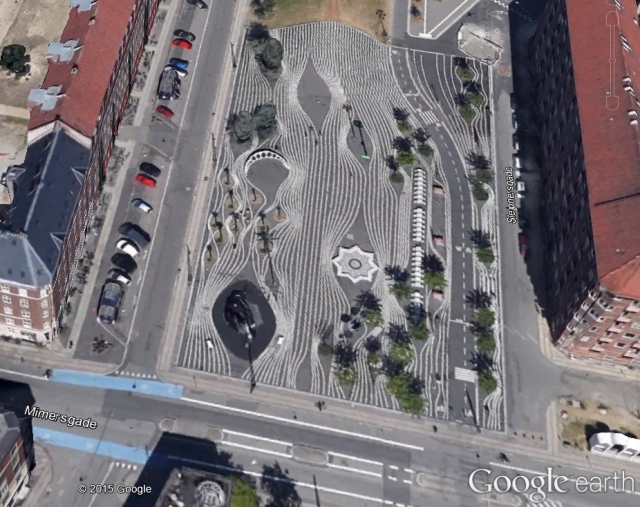
Superkilen (north section), Copenhagen, Denmark
All images obtained from Google Earth.
Category: Promenades
High Line at the Rail Yards
On a recent March weekend while visiting New York City, I had the opportunity to walk the newest section of the High Line that opened last September. This half-mile long segment wraps around a large storage yard for commuter trains, between West 30th and West 34th Streets, with a nice view of the Hudson River along part of its length. The final 1/3 mile of this new phase is currently open as an interim walkway, to be completed once the neighboring Hudson Yards mixed-use development is built on a platform over the train yard.
One can now walk the entire 1.5-mile length of this former freight train trestle. It’s become a very popular place for both locals and visitors, with a steady stream of walkers even on the cool and windy day when I was there. The High Line ranks as one of my favorite urban parks, with a creative design that incorporates many references to its historic railway usage. I also enjoy the numerous interesting views of the city from 30 feet above the streets.
Be sure to check out my other two blog posts on this terrific linear park: Up on the High Line and The High Line, Section 2.
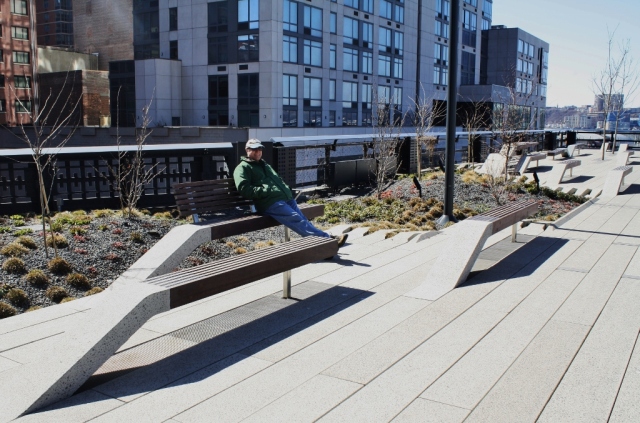
The Grasslands Grove features a variety of “peel-up” furnishings, including benches, a picnic table, a see-saw rocker, and a chime feature for children. This signature style of site amenity can be seen along many parts of the High Line.
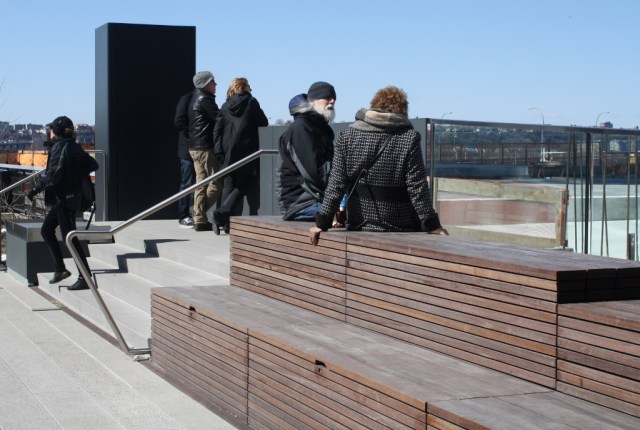
Stacked seating borders the section that parallels West 30th Street, near a new building that is under construction to the north. The landscape near the High Line in this area will be changing over the next few years as tall buildings transform the low-lying rail yards site.
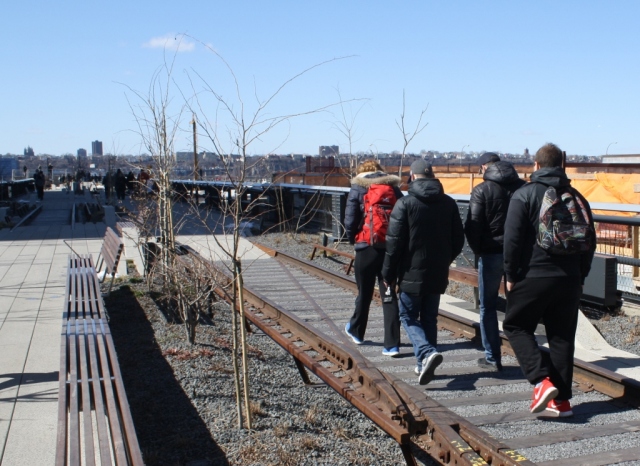
The high line’s original rail tracks are exposed and now function as walkways in three places along the route, referencing the park’s former use. Aggregate bonded with an adhesive was installed between the ties, creating a very firm and level surface, accessible to wheelchairs.
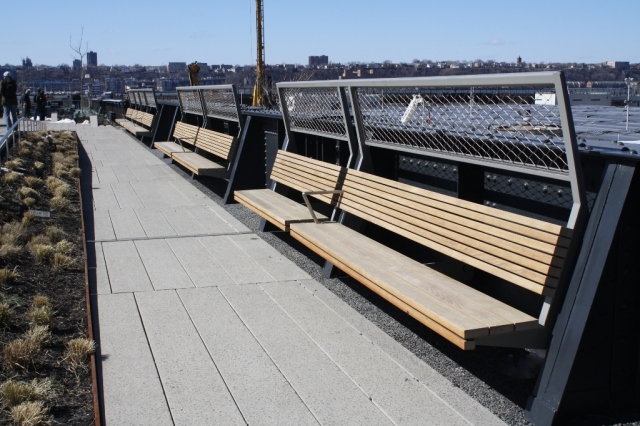
A row of benches flanks the 11th Avenue “Bridge” (to the left of the photo), a section of walkway that arches somewhat above the surrounding surfaces. The rail yards can be seen to the right.
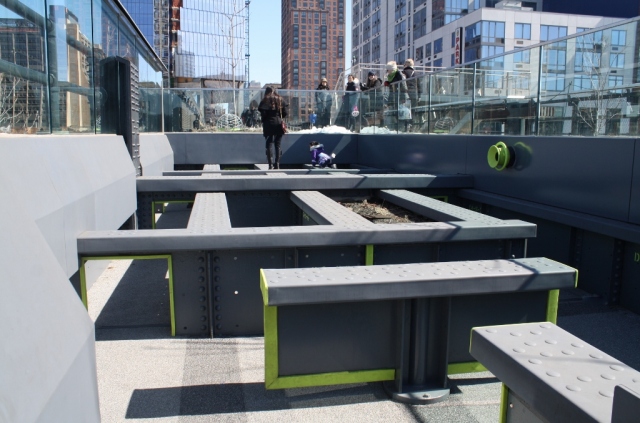
The Pershing Square Beams: A children’s play area featuring an exposed portion of the High Line’s original framework, and also including entertaining elements such as periscopes and a “gopher hole”. In the warmer months, perennial plantings sprout up in the spaces between some of the beams.
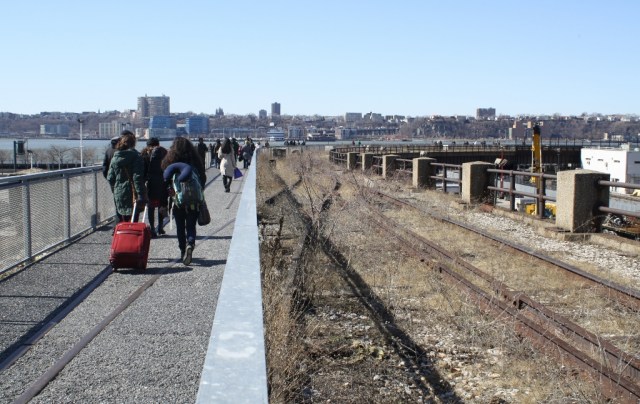
The interim walkway includes the original tracks with self-seeded plants (as the High Line had appeared for many years after the trains stopped running in 1980). It becomes a lush green linear meadow during the warmer seasons. The walkway portion is surfaced with bonded aggregate, flush with the intersecting rail lines. The High Line curves to the right to run parallel with the Hudson River in the distance.
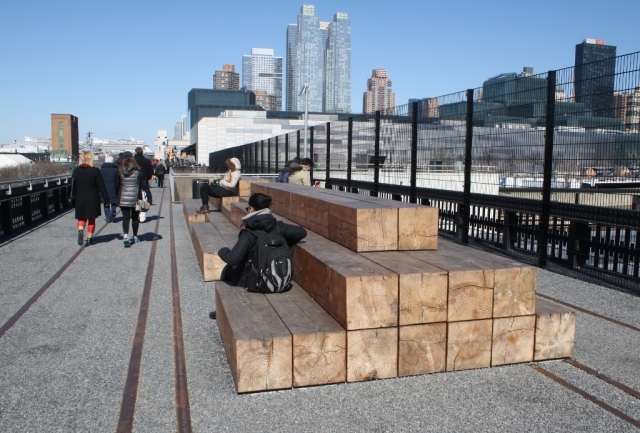
Large stacked timbers serve as seating at this section of the interim walkway, somewhat reminiscent of oversized railroad ties.
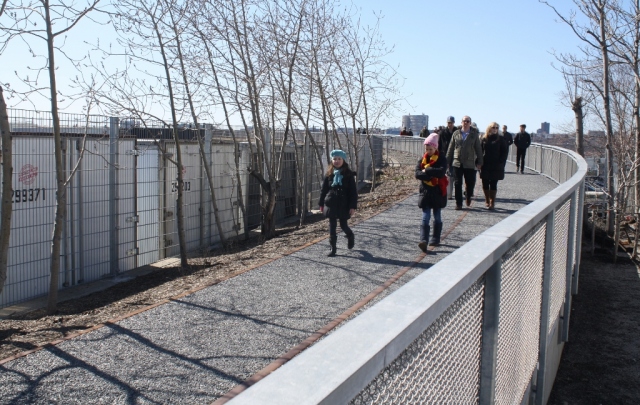
The interim walkway slopes down to its terminus at West 34th Street.
Photos by Alice Webb
Fort Lauderdale Wave Wall and Promenade
In the late 1980s, the beachfront of Fort Lauderdale, Florida, was vastly transformed when the 2-mile-long Wave Wall and Promenade were built, in addition to the redesign of coastal Route A1A to include planted medians and bike lanes. This streetscape improvement project was designed by EDSA, a Florida-based landscape architecture firm. I visited the beach in April, and enjoyed my walks along this promenade. I was impressed not only by the design, but also by how well it has held up over the decades.
A Riverside Promenade in Quebec
To follow up on my last post about promenades, one fine example that I visited recently is a 2.5-km. greenway along the Saint Lawrence River in Quebec City. The Promenade Samuel de Champlain was completed in 2008 in commemoration of the 400th anniversary of the founding of the city. It includes separate pedestrian and bicycle paths, contemporary art, and intersecting gardens/walkways with references to the natural and historical significance of the river. Champlain Boulevard, a major roadway leading into lower Quebec City, was improved and incorporated into the design.
I only had the time to see a couple sections of this extensive waterfront esplanade – below are a few images from my visit.
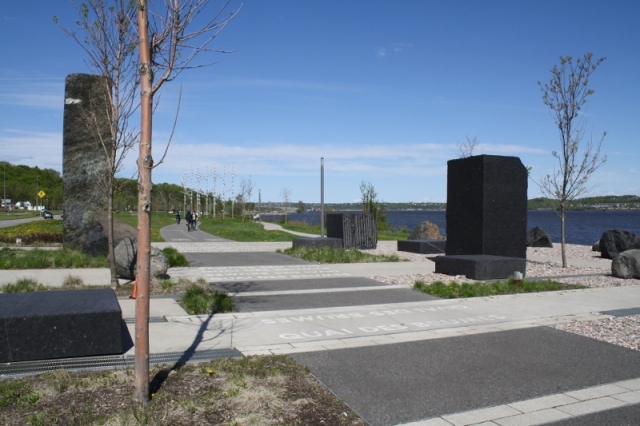
Quai des Brumes (Quay of Mists) is one of several walkway/garden areas crossing the promenade. In summer, linear grates emit mist, referencing the occasional riverine conditions. Geometric stone monoliths are juxtaposed with natural boulders at this site.
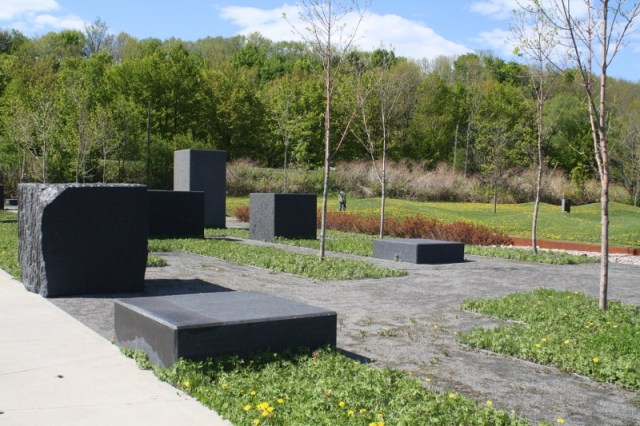
The Quai des Brumes garden continues across Champlain Boulevard, perpendicular to the promenade. Other garden areas along the route also cross in a similar manner.
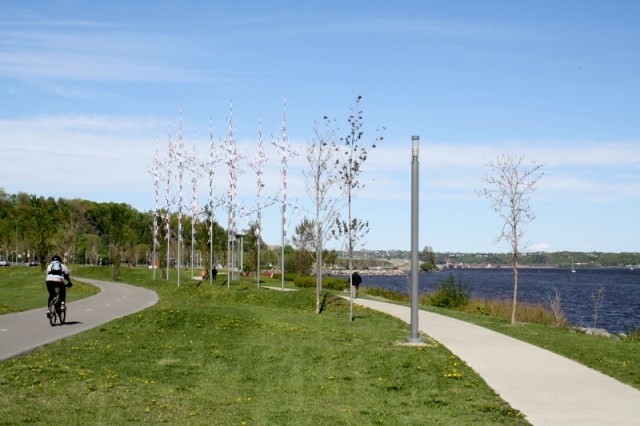
This is another area with an art installation, in this case mimicking the trees. Bicycle and pedestrian ways are separate throughout most of the promenade’s length.
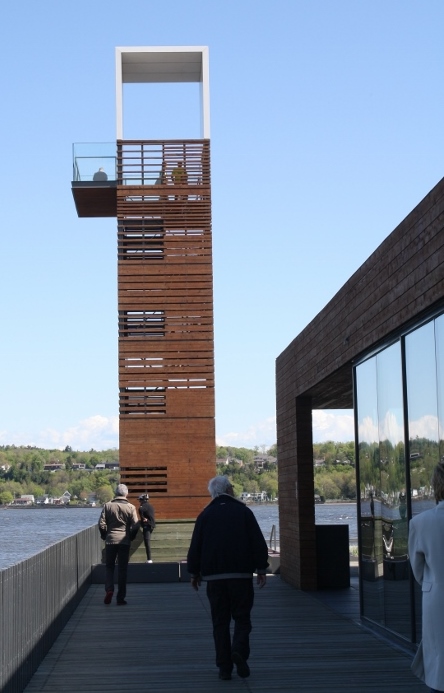
Observation tower at the Cageux Pier, marking the west end of the promenade
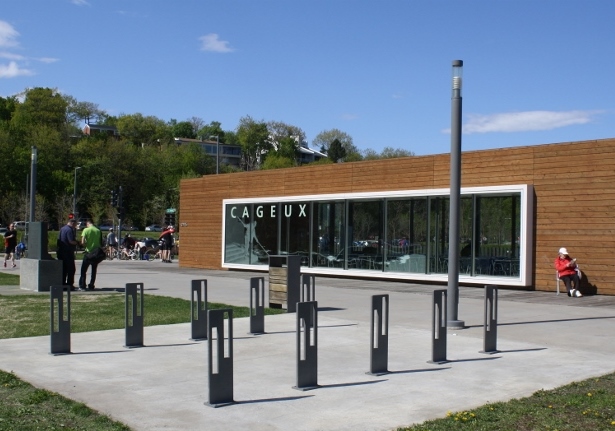
An array of bike stands is situated next to a multipurpose building at the Cageux Pier.
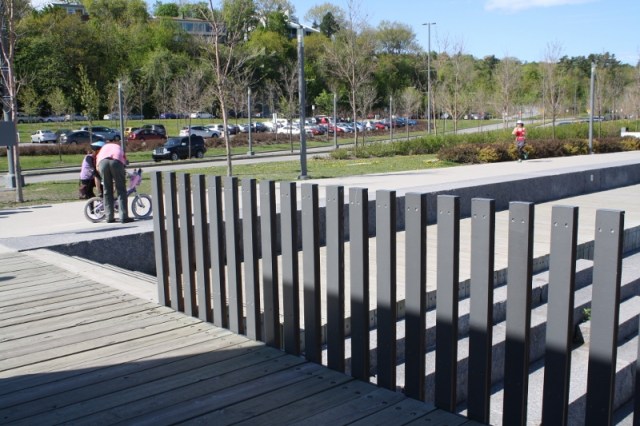
I like how the vertical lines of this railing transect the shadows of seating/steps that lead down to the river’s edge.

At the western end of the promenade, the bicycle path separates (to the left) from the pedestrian walkway.
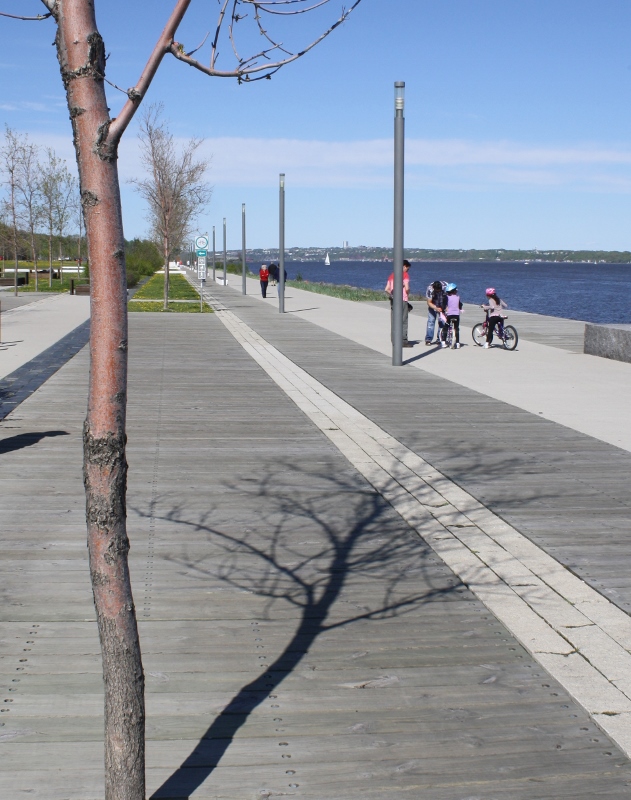
Nice combination of wood decking, pavers, and concrete along the pedestrian section of the promenade. (The bicycle path diverges to the left at this point.)
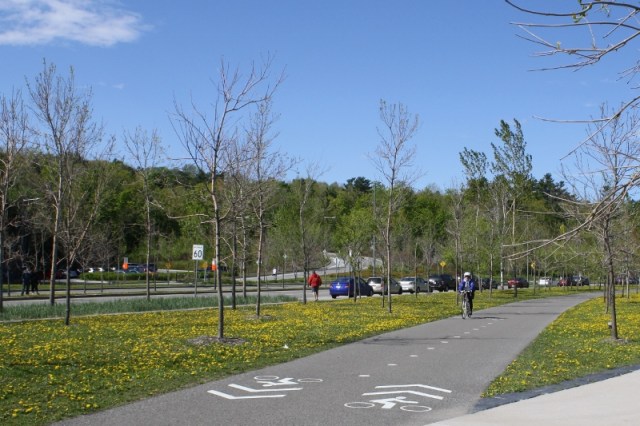
Bicycle section of the promenade – the dandelions on each side of this trail actually look great en masse.
Photos by Alice Webb
Pedestrian Promenades
During my recent travels, I have seen a number of notable walkways along waterfronts, beside city streets, and through urban and suburban parks. Well-designed pedestrian ways have ample width for movement and social interaction, and include visually-unifying elements throughout, such as a continuous paving pattern and repeated furnishings and plantings. These promenades should also be designed to correspond with the character of their surroundings, as well as provide a pleasant and safe experience for pedestrians.
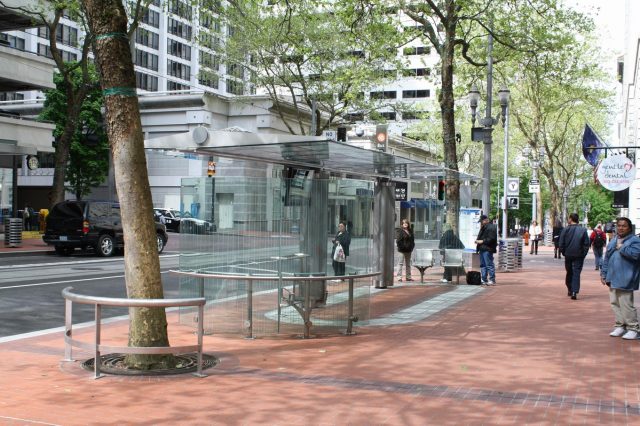
The transit mall in downtown Portland, Oregon, has wide sidewalks with decorative pavement, beside streets that have traffic lanes reserved for light rail and buses. The walkways include these attractive clear transit shelters.
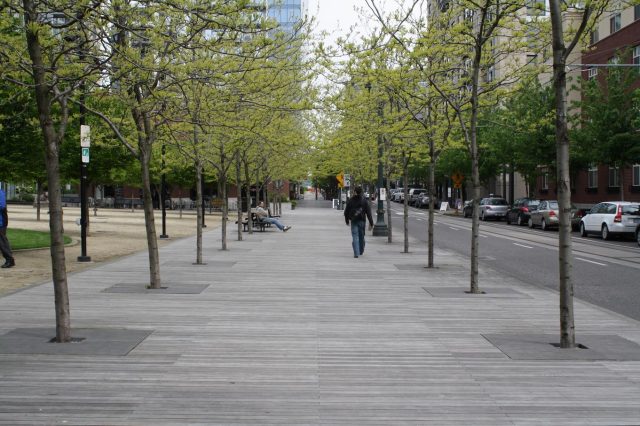
A boardwalk runs along NW 10th Avenue in Portland, Oregon for 4 blocks between two parks. It’s unusual to see a wooden walkway along an urban street. This section, which is adjacent to Jameson Square, is wide enough for a double row of trees – a pleasant place to take a stroll.
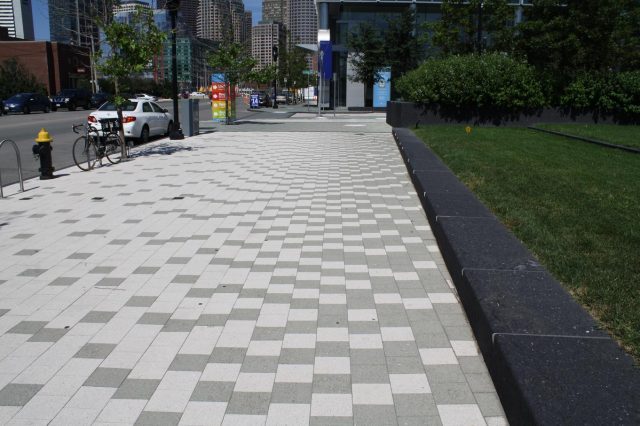
Eye-catching pavement pattern along a portion of Northern Avenue, adjacent to the Fan Pier Public Green in South Boston, Massachusetts
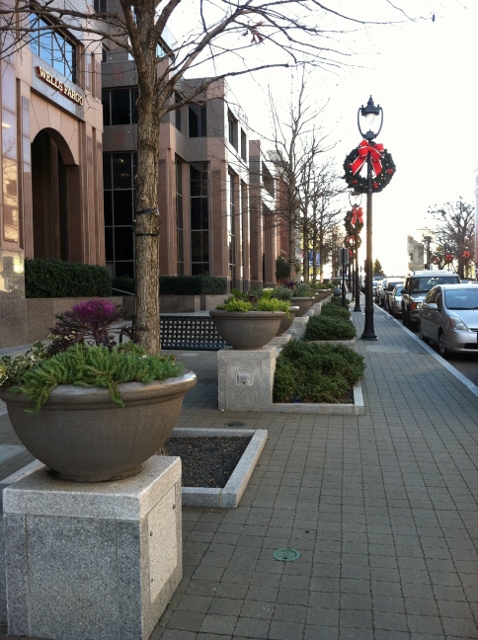
Fayetteville Street in Raleigh, North Carolina, was turned into a pedestrian mall in the 1970s, but the street was added back in 2006 along with these wide sidewalks with decorative planters, benches, lights, and other features. This corridor’s revitalization is reported to be a success in terms of bringing in more business.
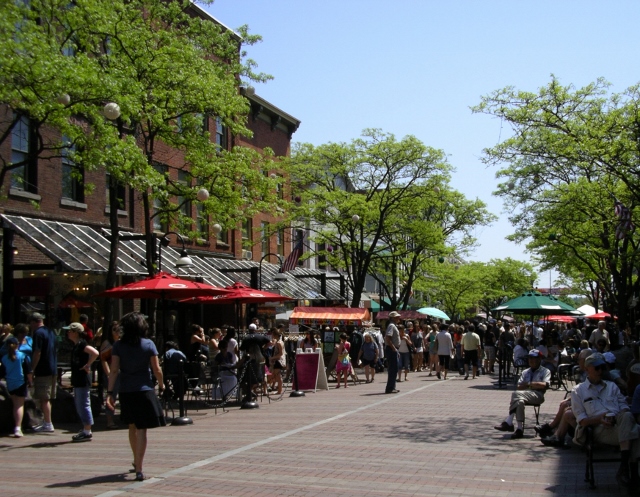
The Church Street Marketplace, in Burlington, Vermont, has been in place since 1981, and is one of the few continuously successful pedestrian malls in the U.S. This lively promenade is full of retail stores and restaurants with outdoor seating areas.
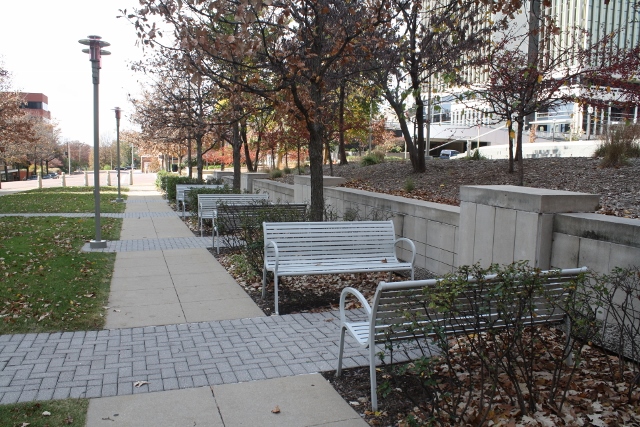
This park in Clayton, Missouri, includes a linear lawn space extending between two streets, bordered by two walkways. Seating areas and plantings line the edges of the promenade. Not many people were outside on this cold day in late October.
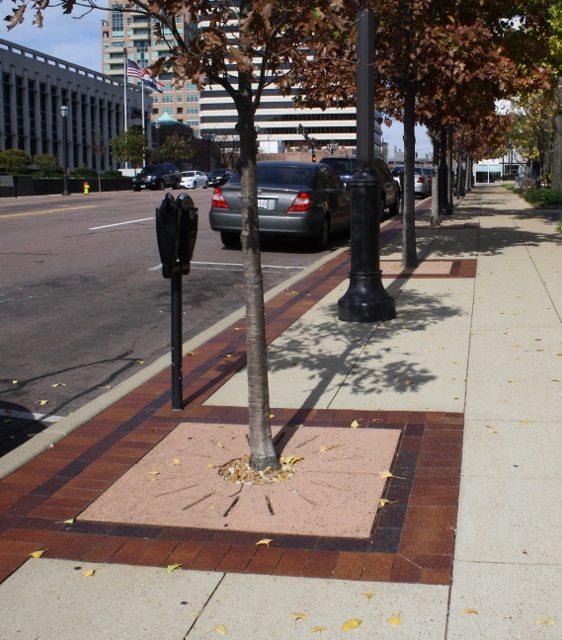
A simple but attractive pavement design along a street in Clayton, Missouri
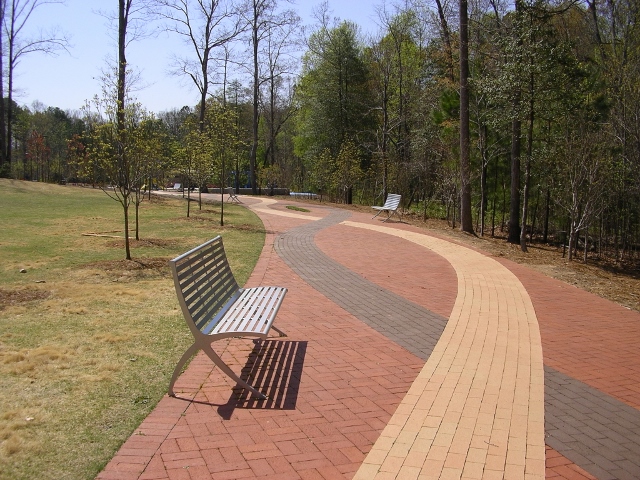
This beautifully-patterned brick walkway winds its way through Walnut Street Park in Cary, North Carolina.
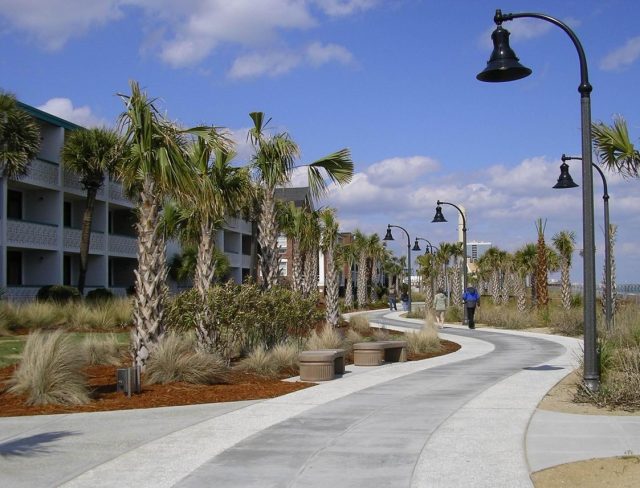
This curvilinear promenade runs along part of the ocean in Myrtle Beach, South Carolina. It is surfaced with concrete in contrasting colors and textures.
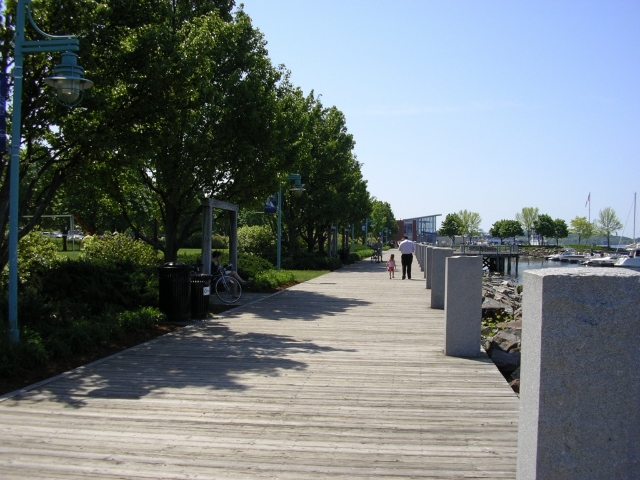
Waterfront Park in Burlington, Vermont, is bounded by a boardwalk which includes nautical-style lighting, granite bollards, and swinging benches.
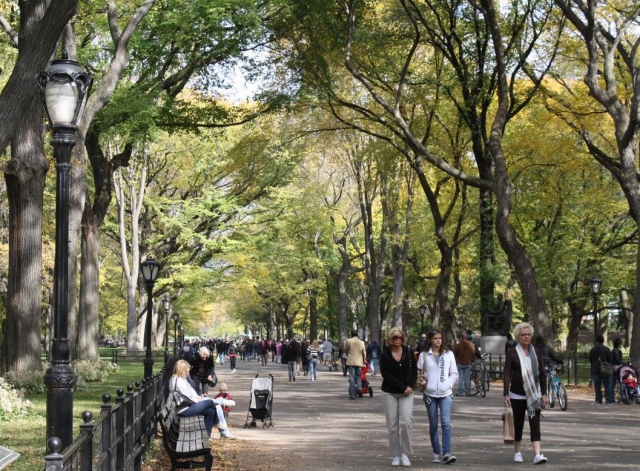
The Mall in Central Park, New York City, is an example of a historic promenade with lovely old trees.
Photos by Alice Webb
Myrtle Beach Boardwalk & Promenade
On a recent trip to Myrtle Beach, South Carolina, I had the opportunity to walk the new Oceanfront Boardwalk & Promenade. The 1.2-mile long walkway runs between two piers (at 2nd and 14th Avenues North), and is situated behind the sand dunes along the beach. The southern section, called the Promenade, is a linear park consisting of a 12’-wide concrete walkway that meanders through lush landscaping. It also includes several narrower looped paths off the main walk, as well as raised beach access connections. Flanking this area is a row of older hotels. To the north of the Promenade is a wide section of wooden boardwalk, located in a zone of beachfront shops and cafes. The final segment is a narrower, winding boardwalk that connects with the 14th Street Pier.
I like the winding layout of the Promenade walkway, with the gray colored concrete strip in the middle, lined by exposed aggregate concrete along each side (the same gray concrete mixed with white shell fragments, in this case). Also, the secondary loop walkways have a nice pitted texture for variation. The only color choice for surfacing that I don’t particularly like is the mottled coloration of the bricks used at maintenance vehicle access crossings and in combination with concrete beneath the canopied areas along the walkway. A solid color would have looked more harmonious with the other materials used for this project.
Palmetto trees are abundant along this linear section of park, along with beds of various evergreen shrubs and ornamental grasses. These low plants contrast nicely with each other, and make an effective visual transition to the more natural-appearing grass plantings on the sand side of the walkway. An occasional grove of Live Oaks would have been nice, breaking up the monotony of the Palmettos, but I understand that these would have blocked ocean views from the lower floors of the hotels. However, natural salt spray pruning would keep the oaks at a small size.
Wood decking was used for the wider boardwalk areas – although higher-maintenance than recycled plastic planks, the wood is aesthetically pleasing and it evokes nostalgia of historic beachside boardwalks. I like the checkerboard pattern of the wood decking, in addition to the light fixtures and other site amenities.
My least favorite section of the Boardwalk & Promenade is the northern segment. It consists of a winding 8’-wide boardwalk that connects with the 14th Avenue Pier at its terminus. Although there is less real estate in this area between private properties and beach, this walk should have been around 12’ wide (like the Promenade walkway). The curving layout of the boardwalk also has an awkward appearance, and the narrow width makes it seem like a cattle corral.
Overall, the new Boardwalk & Promenade is a huge improvement to this section of Myrtle Beach. It offers visitors an alternative to walking on the beach, and one round trip of 2.4 miles can provide plenty of exercise. It will also likely spur more upscale development than what currently exists in this part of the beach.
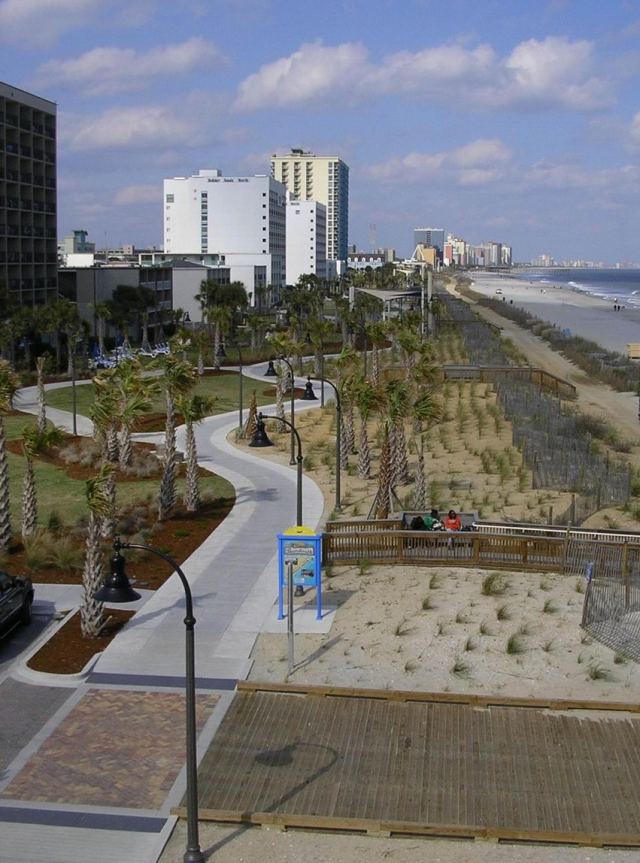
The Promenade, as viewed from the 2nd Avenue Pier
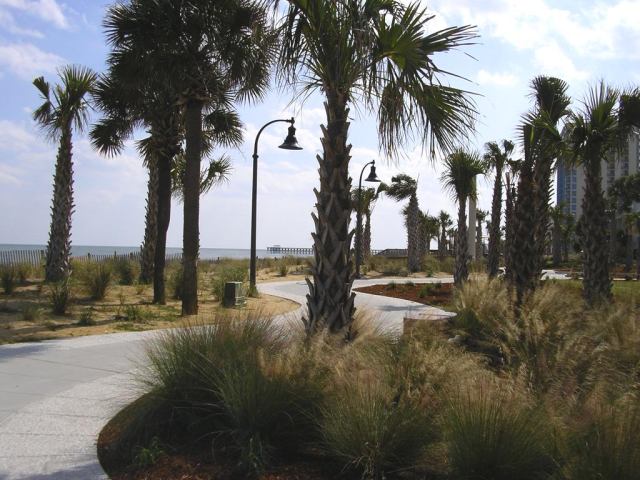
A section of the Promenade with ornamental grasses

The widest segment of the Boardwalk, with a good view of the beach & ocean

This section of boardwalk is adjacent to shops and cafes.
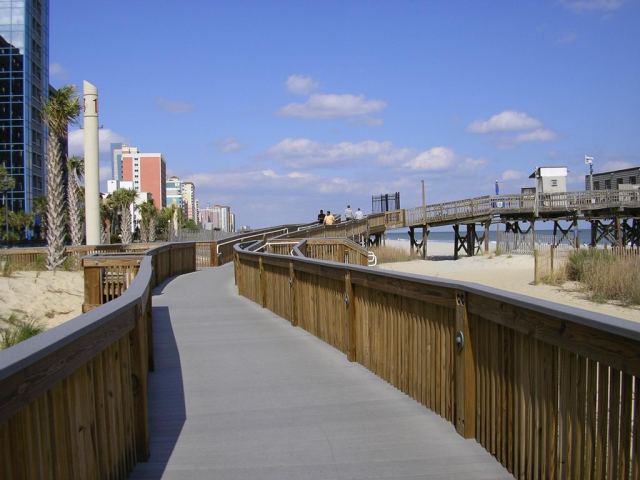
The narrow north portion of boardwalk connects to the 14th Avenue Pier.
Photos by Alice Webb

